Togo is facing a wave of furious protests following a controversial constitutional change that has entrenched the power of long-serving leader Faure Gnassingbé. The new law, swiftly adopted without public referendum earlier this year, transitions Togo to a parliamentary system on paper. In practice, it shifts executive power from the presidency to a now all-powerful prime ministership, a role occupied by Gnassingbé himself.
This strategic reshuffle allows the 59-year-old, who has been in power since 2005, to sidestep presidential term limits while maintaining full control over the government and armed forces. His Union pour la République (Unir) party continues to dominate parliament, thanks to a heavily skewed electoral map that underrepresents opposition strongholds in the south.
The move has sparked outrage on the streets of the capital, Lomé, where at least five demonstrators have died in recent weeks. Notably, it is not opposition politicians but artists, bloggers, and cultural figures who are leading the outcry. Rapper and activist Essowe Tchalla, known as “Aamron”, became a symbol of resistance after he was forcibly detained and confined to a mental hospital, sparking protests on 5 and 6 June.
Aamron’s treatment reminiscent of Soviet-era repression has galvanised the youth-led protest movement. Social media campaigns like #FaureMustGo and a new initiative, the M66 Movement, named after Gnassingbé’s birthday, are gaining momentum.
Despite attempts to present the constitutional change as a democratic reform aligned with Commonwealth principles, critics describe it as a calculated ploy to extend a dynasty that began with Gnassingbé’s father in 1967. The new president, Jean-Lucien Savi de Tové, 86, holds only ceremonial power.
International response has been muted, with global attention elsewhere and regional bloc Ecowas reluctant to act amid its own internal instability. But on the ground in Togo, the atmosphere is increasingly volatile.
With opposition parties weakened and elections marred by apathy, it is cultural icons not politicians who are channeling the growing frustration of a youth population weary of nearly six decades of Gnassingbé rule. Whether this creative uprising can shift the political landscape remains to be seen.

